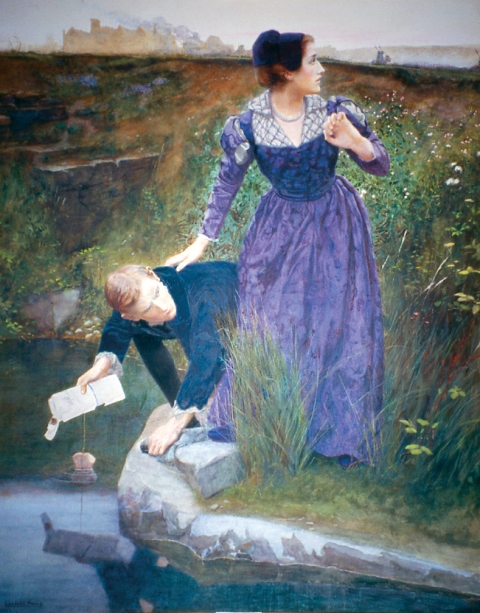
Lexden Lewis Pocock, Dangerous Documents, c.1900, watercolour on paper, Aigantighe Art Gallery Collection, 1956.50
In the early 20th century a private collection of 77 watercolours belonging to Mr and Mrs Fletcher-Johnston travelled to New Zealand with the intention of finding new owners. This exhibition was made up of artworks by English and Australian artists and previously displayed at the prestigious Royal Academy and Royal Institute in London. The show generated a lot of interest and large numbers of visitors were reported to attend as the show travelled Aotearoa.[i]
This exhibition included 11 artworks by the British artist, Lexden Pocock. One painting that drew particular attention was the large watercolour, Dangerous Documents, c.1900, that had been reviewed and “earned much praise”[ii] while displayed in the Royal Academy in London.
Dangerous Documents depicts a young man and woman, poised ready to drop a bundle of documents to the bottom of a pond. We are unsure of the couple’s identity, but like the work of many English Pre-Raphaelite artists of the late 19th century, it is romantic in nature and has a historical or literary narrative. Set during the English Civil War (1642 – 1651) – between the Royalists (or Cavaliers) and those who supported Parliament and leadership of Oliver Cromwell (or the Roundheads) – the lady in the painting stands with one hand on a man who crouches on the edge of a pond. Gaging by the quality and style of the couple’s clothing, they are wealthy and likely land-owners. Considering the rich royal purple hue of the woman’s dress, the couple are Royalists.
The reason for the couple’s pose of breathless concern is the Roundhead soldiers on horseback, with spears slung over their shoulders, who are making their way across the skyline in the painting – possibly following a path that winds around toward the prepared couple. These horsemen, and their invisible comrades, are responsible for the smouldering buildings in the top left corner of the painting. But, one whisper from the standing lady on-the-look-out, one firm tap from her right hand resting on the gentleman’s upper back, will send those confidential and incriminating documents to their disintegrating end at the bottom of the pond – a promised outcome by the rock securely tied to their midriff.
Pocock’s watercolour has been compared before to a painting by one of the founders of the Pre-Raphaelite Brotherhood – John Everett Millais’ A Huguenot on St. Bartholomew’s Day, 1852. Where, in the garden, before an ivy covered brick wall, a young woman in a purple dress (who is Catholic) tries to save the young lover she embraces by tying a white band on his arm (a Protestant or Huguenot) from what was to become the St. Bartholomew’s Day Massacre in 1572. The couples in both paintings have been captured in an emotionally charged moment in the outdoors - either before a clay bank or a clay coloured brick wall. In both paintings the women wear purple dresses of elaborate fabric, and in both paintings the women forewarn of approaching danger.
Of course, by the time this exhibition of artworks belonging to Mr and Mrs Fletcher-Johnston reached Timaru in 1913 (being displayed in the Messrs O’Callaghan and LeCren Rooms), the praise of Pocock’s Dangerous Documents had preceded it. A member of the Timaru Art Society, J. P Newman, wrote to the editor of the Timaru Herald on 19 April 1913, asking if any of the Herald’s readers were interested in subscribing to raise funds to purchase a painting from the exhibition. There was a generous response. The popular Dangerous Documents was selected, the money gathered, and the work purchased for just over £62. By 2 May 1913, the Timaru Herald reported that Dangerous Documents would be added to the “nucleus” of artworks that had been “secured for the Timaru art gallery.”
Why did this particular painting hit such a cord within the hearts of the people of Timaru and wider New Zealand? The travelling exhibition found New Zealand at a time when there was a strong connection to the Mother Land, and while New Zealand was rallying to support England and serve King George V in the First World War. In fact, from 1909 the public of Aotearoa had funded the construction of a large battlecruiser for the Royal Navy (costing tax payers £1.7 million); the finished battlecruiser, the HMS New Zealand, visited Aotearoa in 1913 and 500, 000 people made the effort to visit it – approximately half the country’s population.[iii] It is possible that the young Royalists’ devotion to King and Country – especially when it could cost life – seemed to capture the patriotism, fearless duty and sense of identity of New Zealanders.
The South Canterbury Art Society’s ‘nucleus’ art collection joined the art collection of the Grant family when Helen Grant left her home and grounds to the people of South Canterbury to realise the dream of Timaru’s own public Art Gallery – the Aigantighe Art Gallery opened in 1956. While this story of how the dramatic watercolour, Dangerous Documents, came into the Aiganighe’s collection, is one of a community banding together with a shared goal they considered important.
Little is known about Lexden Lewis Pocock (1850 – 1919), other than he was born and lived in London, that he studied at Slade School of Art and the Royal Academy Schools, and also travelled, studied and taught art in Rome. He was known to have exhibited at the Royal Academy, the Royal Society of British Artists, and the Royal Institute – meaning that he was an active and esteemed artist of his time.
Petrena Fishburn
[i] New Zealand Times, 15 October 1909, p.8.
Dominion, 15 May 1912, p.6.
[ii] Timaru Herald, 19 April 1913, p. 10.
[iii] Ministry of Culture and Heritage, New Zealand History: A History of New Zealand 1769 – 1914 https://nzhistory.govt.nz/culture/history-of-new-zealand-1769-1914#heading9 [30 March 2020]